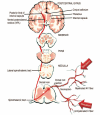Perioperative Pain Management in Total Hip Arthroplasty: Korean Hip Society Guidelines
- PMID: 27536639
- PMCID: PMC4972874
- DOI: 10.5371/hp.2016.28.1.15
Perioperative Pain Management in Total Hip Arthroplasty: Korean Hip Society Guidelines
Abstract
Effective perioperative pain management techniques and accelerated rehabilitation programs can improve health-related quality of life and functional status of patients after total hip arthroplasty. Traditionally, postoperative analgesia following arthroplasty was provided by intravenous patient-controlled analgesia or epidural analgesia. Recently, peripheral nerve blockade has emerged alternative analgesic approach. Multimodal analgesia strategy combines analgesics with different mechanisms of action to improve pain management. Intraoperative periarticular injection of multimodal drugs is one of the most important procedures in perioperative pain control for total hip arthroplasty. The goal of this review article is to provide a concise overview of the principles of multimodal pain management regimens as a practical guide for the perioperative pain management for total hip arthroplasty.
Keywords: Analgesics; Pain control; Total hip arthroplasty.
Conflict of interest statement
Figures

References
-
- Larsen K, Hansen TB, Thomsen PB, Christiansen T, Soballe K. Cost-effectiveness of accelerated perioperative care and rehabilitation after total hip and knee arthroplasty. J Bone Joint Surg Am. 2009;91:761–772. - PubMed
-
- Fischer HB, Simanski CJ. A procedure-specific systematic review and consensus recommendations for analgesia after total hip replacement. Anaesthesia. 2005;60:1189–1202. - PubMed
-
- Buvanendran A, Kroin JS, Tuman KJ, et al. Effects of perioperative administration of a selective cyclooxygenase 2 inhibitor on pain management and recovery of function after knee replacement: a randomized controlled trial. JAMA. 2003;290:2411–2418. - PubMed
-
- Wall PD. The prevention of postoperative pain. Pain. 1988;33:289–290. - PubMed
Publication types
LinkOut - more resources
Full Text Sources
Other Literature Sources
Medical

